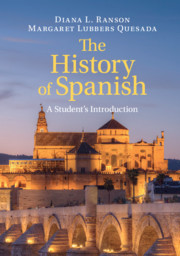Description
The History of Spanish
A Student's Introduction
Authors: Ranson Diana L., Quesada Margaret Lubbers
Provides students with an engaging and thorough overview of the history of Spanish and its development from Latin.
Language: English
Subject for The History of Spanish:
Approximative price 43.23 €
In Print (Delivery period: 14 days).
Add to cart
The History of Spanish
Publication date: 10-2018
452 p. · 17.5x24.5 cm · Paperback
Publication date: 10-2018
452 p. · 17.5x24.5 cm · Paperback
Approximative price 96.55 €
In Print (Delivery period: 14 days).
Add to cart
The History of Spanish
Publication date: 10-2018
452 p. · 17.8x25.3 cm · Hardback
Publication date: 10-2018
452 p. · 17.8x25.3 cm · Hardback
Description
/li>Contents
/li>Biography
/li>
This concise textbook provides students with an engaging and thorough overview of the history of Spanish and its development from Latin. Presupposing no prior knowledge of Latin or linguistics, students are provided with the background necessary to understand the history of Spanish. Short, easy-to-digest chapters feature numerous practice exercises and activities. Chapter 'Lead-in' questions draw comparisons between English and Spanish, enabling students to use their intuition about their native language to gain a deeper understanding of Spanish. Each chapter features further reading suggestions, an outline, and a summary. Highlighted key terms are collated in a glossary. Boxes on linguistic debates teach students to evaluate arguments and think critically about linguistics. Supporting online resources include Word files of all the practices and activities in the book and an instructor's manual featuring a sample syllabus, answer key to the practices and activities, sample exams and teaching suggestions. This book is ideal for a range of courses on the history of Spanish and Spanish linguistics.
List of figures; List of maps; List of tables; Preface for students; Preface for instructors; Acknowledgments; 1. Why do Spanish speakers say el arte but las artes? The value of studying the history of Spanish; 2. Is it wrong to say cantastes instead of cantaste? A linguist's attitude and approach to language; 3. How and why do languages change and how do linguists know?; 4. Did /f/ change to /h/ in Spanish because of Basque? Four moments of language contact in the history of Spanish; 5. Why is Spanish also called Castilian? The standardization process and its effects; 6. How did FESTA become fiesta but FESTÎVUM became festivo? Regular vowel changes; 7. How did ACÛTUM become agudo? Regular consonant changes; 8. Why is 'milk' leche but 'Milky Way' is Via Láctea? Special tonic vowel changes; 9. Why fieldad but lealtad? Special consonant changes; 10. Why do Spanish speakers sometimes say andé instead of anduve? Morphological changes; 11. Why is mano feminine and día masculine? Changes in case, declension, number, and gender; 12. Why do Spanish speakers sometimes say más malo instead of peor? Origins of nominal elements; 13. Why are there so many verb tenses in Spanish? Origins of verbs; 14. Why is comeré the future of comer but sabré is the future of saber? How regular sound change and analogy lead to regular and irregular forms; 15. Do you say veo el gato or veo al gato? Syntactic changes; 16. How did MÛSCŬLUM 'little mouse' become Spanish muslo 'thigh'? Semantic changes; 17. Why perro 'dog' instead of can? Lexical changes; Appendix: Selections from old Spanish texts; El Auto de los Reyes Magos; Cantar de mio Cid; Razon feita d'amor; Milagros de Nuestra Señora; Calila e Dimna; Glossary of terms; Works cited; Word index; Subject index.
Diana L. Ranson is Professor of French and Spanish at the University of Georgia. Her publications include Change and Compensation: Parallel Weakening of /s/ in Italian, French and Spanish (1989) and articles on Spanish historical linguistics, syntactic variation in Modern Spanish, and phonological variation in Modern French. She has taught the History of Spanish, the History of French, Comparative Romance Linguistics, and Old Spanish for over thirty years.
Margaret Lubbers Quesada is Professor of Spanish at the University of Georgia. Her recent publications include The L2 Acquisition of Spanish Subjects Multiple Perspectives (2015), and articles in journals, such as the International Review of Applied Linguistics, Journal of Pragmatics and Language Learning, The Handbook of Spanish Second Language Acquisition, and Estudios de Lingüística Aplicada. She teaches courses in theoretical, applied, and historical linguistics.
Margaret Lubbers Quesada is Professor of Spanish at the University of Georgia. Her recent publications include The L2 Acquisition of Spanish Subjects Multiple Perspectives (2015), and articles in journals, such as the International Review of Applied Linguistics, Journal of Pragmatics and Language Learning, The Handbook of Spanish Second Language Acquisition, and Estudios de Lingüística Aplicada. She teaches courses in theoretical, applied, and historical linguistics.
© 2024 LAVOISIER S.A.S.




